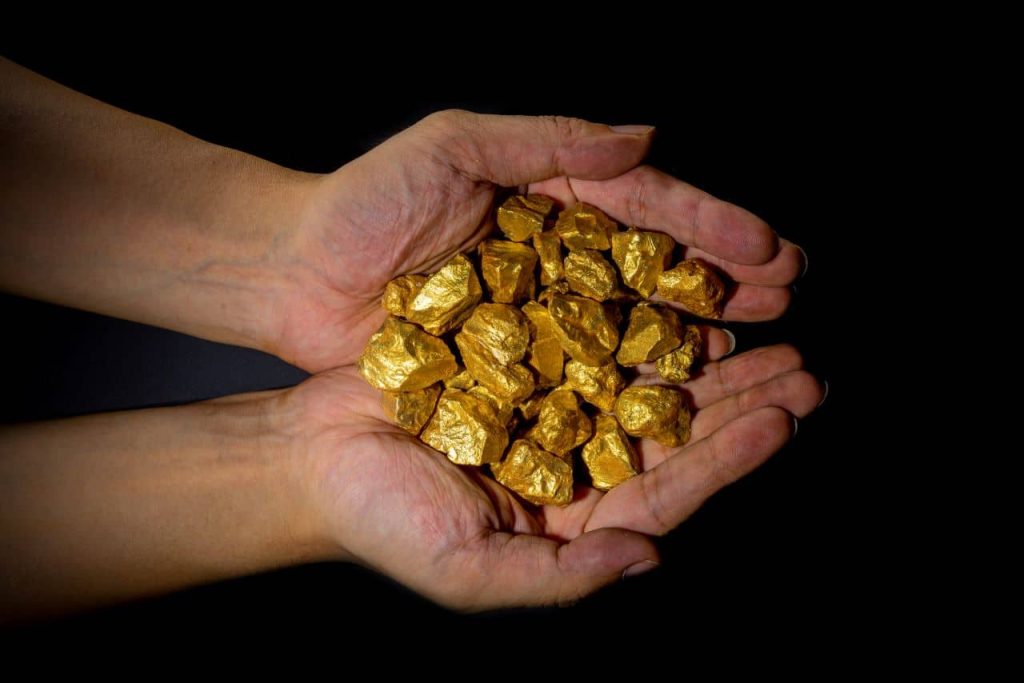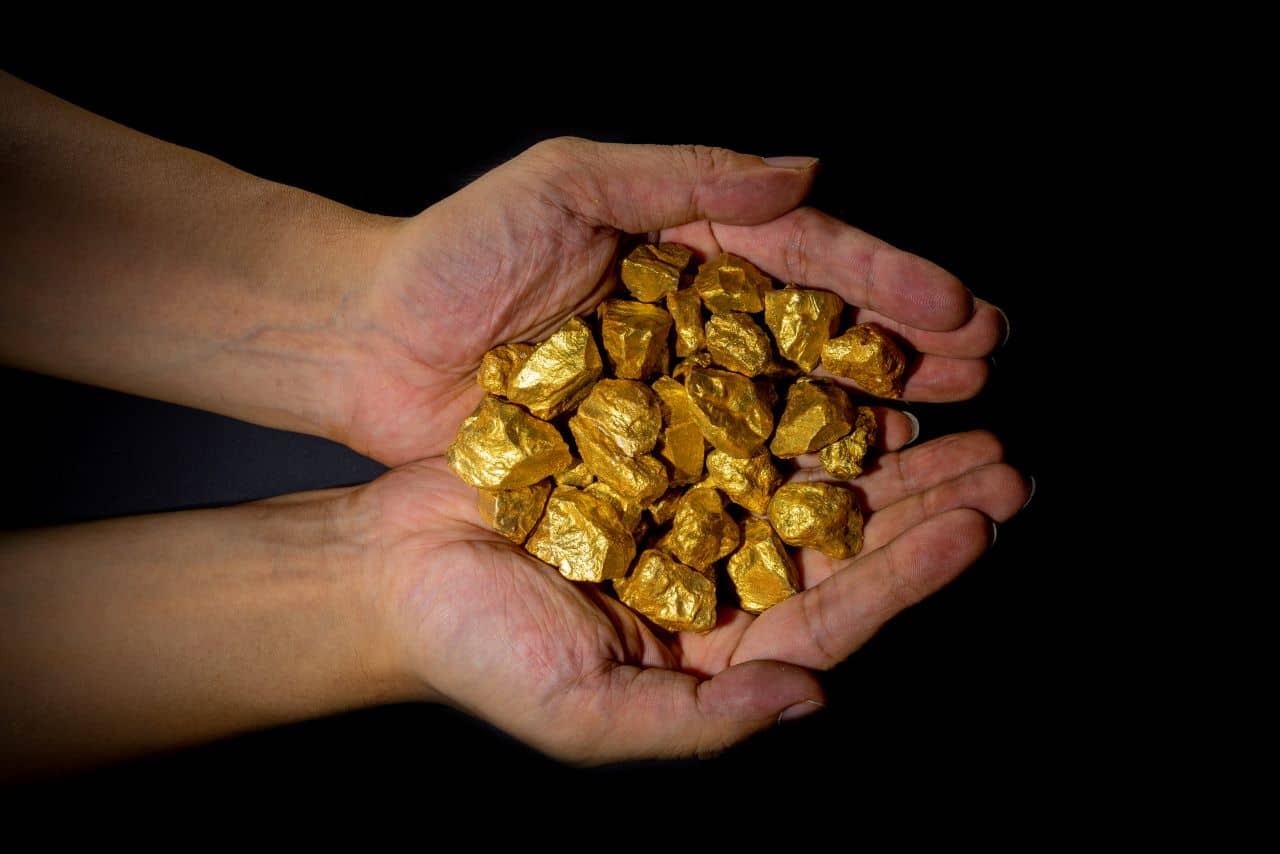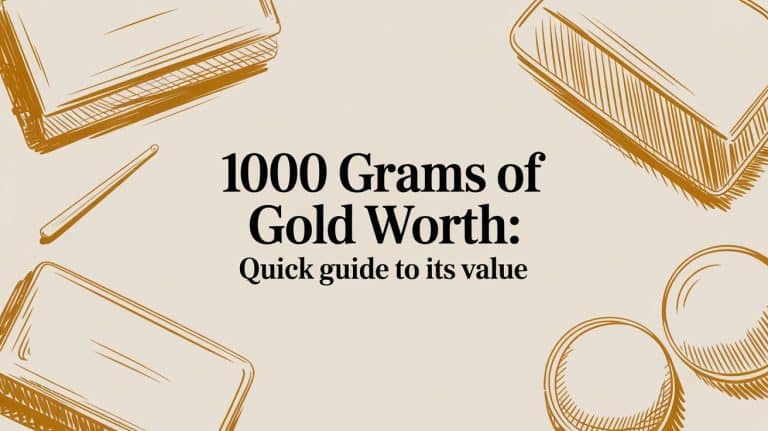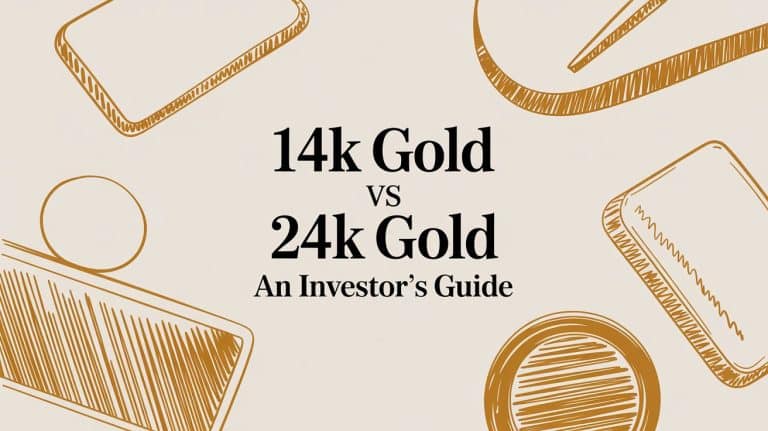What’s the Difference Between 10k, 14k, 18k, and 24k Gold? A Complete Guide
When shopping for gold jewelry, you’ve likely encountered pieces labeled as 14k, 18k, or 24k gold. Understanding the difference between 14k, 18k, and 24k gold is essential for making informed purchasing decisions, whether you’re buying an engagement ring, a special gift, or an investment piece. These numbers aren’t just arbitrary classifications, they reveal crucial information about the gold’s purity, durability, color, and value.
In this comprehensive guide, we’ll explore everything you need to know about gold karatage. From the science behind gold alloys to practical advice for choosing the right karat for your needs, you’ll gain valuable insights to help you navigate the gold jewelry market with confidence.
Gold 10k vs 14k vs 18k vs 24k: Understanding the Basics
Before diving into specific differences, let’s understand what these numbers actually mean. The karat system is a measure of gold’s purity, with 24k representing pure gold (99.9% pure). But what exactly does that mean, and how does it translate to 14k and 18k gold?
What Is a Karat?
The term “karat” (abbreviated as “k” or “kt”) refers to the proportion of pure gold in an alloy out of 24 parts. One karat equals 1/24th part of the whole, or 4.167% pure gold. This means:
- 24k gold contains 24 parts gold out of 24 (100% pure gold)
- 18k gold contains 18 parts gold out of 24 (75% pure gold)
- 14k gold contains 14 parts gold out of 24 (58.3% pure gold)
John Humphrey, master goldsmith at Brinkler’s Jewelers, explains, “The karat system dates back to ancient times when merchants used carob seeds—which have remarkably consistent weights—as counters. Today, it’s our universal standard for measuring gold purity.”
Gold Alloys: Why Pure Gold Isn’t Always Best
You might wonder why jewelers don’t always use pure 24k gold if it’s the highest quality. The answer lies in gold’s natural properties. Pure gold is extremely soft and malleable—too soft for everyday jewelry that needs to withstand normal wear and tear.
This is where alloys come in. By mixing gold with other metals like silver, copper, zinc, nickel, or palladium, jewelers create more durable materials that retain gold’s beauty while gaining practical strength. These additional metals also allow for different color variations like white gold, rose gold, and even green gold.
According to the World Gold Council, “Throughout history, gold’s malleability has been both its greatest asset and biggest challenge for jewelry makers, necessitating the development of gold alloys that balance beauty with wearability.”
Understanding What’s the Difference Between 10k, 14k, 18k, and 24k Gold
To understand the full spectrum of gold quality, let’s examine each common karat weight and its unique properties.
10k Gold: The Entry Level
Although not mentioned in our title, 10k gold deserves mention as it’s commonly found in the marketplace:
- Contains 41.7% pure gold (10 parts out of 24)
- The minimum legally marketable as gold in the US
- Most durable and affordable gold option
- Typically has a lighter, paler yellow appearance
- Excellent for everyday jewelry that will face rough handling
14k Gold: The Popular Middle Ground
14k gold is the most popular choice for jewelry in the United States, striking an excellent balance between several factors:
- Contains 58.3% pure gold (14 parts out of 24)
- Offers good durability with meaningful gold content
- Has a subdued yellow color (less intense than higher karats)
- Resistant to tarnishing and discoloration
- Affordable yet valuable
- Ideal for engagement rings, wedding bands, and daily-wear jewelry
“For active people who want real gold jewelry without worrying about damage, 14k is typically my first recommendation,” says Elizabeth Taylor, jewelry buyer at Ken & Dana Design. “It maintains its appearance beautifully over time with minimal maintenance.”
18k Gold: The Luxury Standard
18k gold represents a sweet spot between purity and practicality:
- Contains 75% pure gold (18 parts out of 24)
- Offers a richer, warmer yellow tone than 14k
- Still reasonably durable for most jewelry applications
- Less likely to cause allergic reactions due to higher gold content
- More expensive than 14k gold
- Popular for high-end jewelry, luxury watches, and special occasions
- The international standard for fine jewelry in many countries
24k Gold: The Ultimate Purity
Pure gold in its most pristine form:
- 24k gold contains 99.9% pure gold (24 parts out of 24)
- Displays a deep, rich yellow-orange color
- Extremely soft and easily scratched or dented
- Too malleable for intricate designs or prong settings
- Highest value by weight
- Rarely used for jewelry except in certain Asian markets
- Primarily used for investment, coins, and bullion
As MMTC-PAMP, one of Asia’s largest gold refiners, notes, “In countries like India and China, 24k gold holds both financial and cultural significance, often purchased as much for investment as for adornment.”

A Side-by-Side Comparison
Here’s a comprehensive comparison table of the different gold karats:
| Property | 10k Gold | 14k Gold | 18k Gold | 24k Gold |
|---|---|---|---|---|
| Gold Content | 41.7% | 58.3% | 75% | 99.9% |
| Alloy Content | 58.3% | 41.7% | 25% | 0.1% |
| Color Intensity | Pale yellow | Medium yellow | Rich yellow | Deep yellow-orange |
| Durability | Excellent | Very good | Good | Poor |
| Tarnish Resistance | Good | Very good | Excellent | Superior |
| Allergy Potential | Higher | Moderate | Low | Minimal |
| Price (relative) | $ | $$ | $$$ | $$$$ |
| Best Uses | Everyday jewelry, children’s jewelry | Engagement rings, wedding bands, daily wear | Fine jewelry, special occasions | Investment, bullion, cultural jewelry |
Which Is Better: 14k or 18k?
This is perhaps the most common question when choosing gold jewelry, and the answer depends entirely on your priorities and how you plan to wear the piece.
Durability Comparison
If durability is your primary concern, 14k gold has a clear advantage:
- 14k Gold: With nearly 42% alloy metals, 14k gold is significantly more resistant to scratching, bending, and general wear. This makes it ideal for rings (especially engagement rings and wedding bands), bracelets, and other pieces that face daily exposure or potential impacts.
- 18k Gold: While still durable enough for most jewelry purposes, 18k gold is about 25% softer than 14k gold. For pieces with intricate details or thin components, this difference can be significant over time.
Michael Chang, metallurgist at Diamonds Pro, explains, “The hardness difference between 14k and 18k is noticeable in laboratory testing but translates to real-world durability differences, especially for jewelry worn daily for decades, like wedding rings.”
Appearance and Color
If the rich color of gold is what attracts you, 18k has the advantage:
- 14k Gold: Has a lighter, more subdued yellow tone due to the higher percentage of other metals.
- 18k Gold: Displays a noticeably warmer, more intense yellow color that many consider the “true” gold look.
Some buyers are surprised to learn that what they envision as the classic “gold color” is actually closer to 18k than 24k gold, which can sometimes appear almost orange in its intensity.
Allergic Reactions and Skin Sensitivity
Those with metal sensitivities should consider gold content carefully:
- 14k Gold: Contains more nickel, copper, or other metals that can potentially cause allergic reactions in sensitive individuals.
- 18k Gold: With its higher gold content and lower alloy percentage, 18k gold is less likely to cause skin irritation or allergic responses.
“For clients with known metal sensitivities, I typically recommend 18k gold or higher,” notes dermatologist Dr. Sarah Williams. “The reduced alloy content minimizes exposure to potentially reactive metals like nickel.”
Value and Investment Potential
From a pure investment perspective:
- 14k Gold: Lower initial cost but also lower gold content means less intrinsic value.
- 18k Gold: Higher gold content means better value retention and potentially better long-term investment.
However, jewelry rarely makes an optimal investment compared to gold bullion or coins, as craftsmanship costs and retail markups significantly reduce the metal’s investment value.
The Verdict: Which Should You Choose?
The better choice between 14k and 18k gold depends entirely on your specific needs:
Choose 14k gold if:
- You plan to wear the piece daily
- The jewelry will encounter potential impacts or rough handling
- You’re on a tighter budget
- Durability is more important than color intensity
Choose 18k gold if:
- The rich gold color is important to you
- You have sensitive skin
- The piece is for special occasions rather than everyday wear
- You value higher gold content for prestige or investment reasons
- You’re purchasing in a market where 18k is the standard (like Europe)
Difference Between 18k and 24k Plated
Gold plating represents an entirely different category that deserves clarification. Many consumers confuse solid gold karats with gold plating, but they’re fundamentally different products.
What Is Gold Plating?
Gold plating involves applying a thin layer of gold over a base metal (typically brass, copper, or silver). The plating process uses electricity to bond a microscopic layer of gold to the surface of the base metal.
Jessica Fernandez, jewelry manufacturing expert, explains: “The term ’18k gold plated’ or ’24k gold plated’ refers only to the purity of the extremely thin gold layer on the surface, not the entire piece. This leads to much consumer confusion about value.”
Key Differences Between Solid Gold and Gold Plated
- Composition: Solid gold (whether 14k, 18k, or 24k) contains gold throughout the entire piece. Gold plated items have only a microscopically thin layer of gold over another metal.
- Durability: The gold plating will wear off over time, revealing the base metal underneath. This typically begins to happen within months to a few years, depending on wear and care.
- Value: Gold plated jewelry derives minimal value from its gold content, as the amount of gold used is negligible.
- Markings: In the US, gold plated items should be marked “GP” (gold plated) or “GEP” (gold electroplated) along with the karat of the plating.
18k vs. 24k Gold Plating Comparison
When comparing 18k and 24k gold plating, the differences are minor:
- Color: 24k plated items will initially have a slightly more intense yellow color than 18k plated items.
- Durability: Contrary to what you might expect, 18k plating can sometimes last longer than 24k plating because the alloys add some hardness to the gold layer.
- Cost: The price difference between 18k and 24k plated items is minimal since the amount of gold used is so small.
According to consumer testing by Consumer Reports, “Most consumers cannot visually distinguish between 18k and 24k gold plating, and both will typically show wear within similar timeframes under normal use.”
Is Gold Plating Worth It?
Gold plating allows for the appearance of gold at a fraction of the cost of solid gold jewelry. For fashion jewelry or pieces you don’t expect to keep for decades, gold plated options can be perfectly reasonable choices.
However, if you’re looking for lasting value or heirloom quality, solid gold (even 10k) will always outlast and outvalue gold plated alternatives.
Beyond Purity: Other Factors That Affect Gold Quality
While karat rating is important, several other factors contribute to a gold piece’s overall quality and value:
Manufacturing Methods
The way gold jewelry is made significantly impacts its quality:
- Cast Gold: Created by pouring molten gold into molds. Generally less expensive but potentially more porous.
- Hand-Forged: Worked by hand from gold stock. Often creates denser, more durable pieces but at higher cost.
- Die-Struck: Stamped under pressure. Creates very consistent, dense pieces ideal for detailed designs.
Richard Wilson, production manager at Melorra, notes that “the manufacturing method can be as important as the karat weight in determining a piece’s longevity.”
Surface Treatments
Many gold pieces undergo treatments that affect appearance and durability:
- High Polish: The classic shiny finish most associate with gold jewelry
- Satin/Brushed: A softer, more subtle sheen that shows fewer scratches
- Hammered: Textured surface that hides imperfections well
- Florentine: Fine lines creating a textured appearance
- Sandblasted: Very matte appearance with a slightly rough texture
These treatments don’t change the gold’s karat weight but can dramatically affect both aesthetics and how the piece wears over time.
Quality of Craftsmanship
Regardless of gold purity, the skill of the craftsperson matters enormously:
- Precision of stone settings
- Evenness of metal distribution
- Quality of joins and clasps
- Attention to detail in finishing
“Two identical 14k gold rings can differ dramatically in quality and longevity based solely on craftsmanship,” explains Thomas Bradley, a third-generation goldsmith. “I’ve repaired poorly made 18k pieces that didn’t last as long as well-crafted 10k jewelry.”
Regional Preferences in Gold Karatage
Interestingly, gold preferences vary significantly around the world:
North America
- 14k gold dominates the market, especially for everyday jewelry and bridal pieces
- 10k gold is common for more affordable mass-market jewelry
- 18k gold is typically reserved for higher-end pieces
Europe
- 18k gold is the standard across most European markets
- 14k gold is less common but available
- Hallmarking standards are typically more stringent than in the US
Asia
- 22k and 24k gold are highly preferred, especially in India, China, and other parts of Southeast Asia
- Gold is often viewed as much for investment as for adornment
- Yellow gold strongly dominates over white or rose gold
According to the World Gold Council, “Cultural differences in gold preferences reflect deeply held views about gold’s purpose—whether primarily decorative, as in Western markets, or as portable wealth, as in many Asian countries.”
Gold Colors Beyond Yellow: How Karat Affects Alternative Gold Colors
While we’ve focused on traditional yellow gold, it’s worth noting how karatage affects other popular gold colors:
White Gold
White gold is created by alloying gold with white metals like nickel, palladium, or silver and usually plated with rhodium for a bright white finish.
- 14k white gold: Contains more alloy metals, often making it naturally whiter before plating
- 18k white gold: Has a slightly warmer undertone due to higher gold content
- 24k white gold: Doesn’t exist in practical terms, as pure gold cannot be made white
Rose Gold
Rose or pink gold gets its warm, pinkish hue from higher copper content in the alloy mix.
- 14k rose gold: Often has a lighter pink color
- 18k rose gold: Displays a more subtle blush tone due to less copper
- 24k rose gold: Not possible, as pure gold cannot have the copper needed for the rose color
Green Gold
Less common but distinctive, green gold (also called electrum) contains silver and sometimes zinc to create a greenish tint.
- 14k green gold: Shows stronger green tints due to higher alloy content
- 18k green gold: More subtle greenish hue
- 24k green gold: Not possible with pure gold
Jennifer Lopez, designer at Auris Jewels, notes that “karat weight affects colored golds even more dramatically than yellow gold, as the alloys creating the color need to be balanced precisely with the gold content.”
Practical Care and Maintenance Based on Karat
Different gold purities require slightly different care approaches:
Care for 14k Gold
- Can withstand regular cleaning with mild soap and water
- Ultrasonic cleaners are generally safe for pieces without stones
- Can handle occasional light impacts
- Benefits from annual professional cleaning and checking of stone settings
Care for 18k Gold
- Clean with gentle methods—soft cloth and mild soap solution
- Be more cautious with ultrasonic cleaners
- Avoid impacts and scratches from harder materials
- Store separately from other jewelry to prevent scratching
Care for 24k Gold
- Requires very delicate handling
- Clean only with soft cloths, never abrasive materials
- Store in protective cases, separate from all other items
- Avoid wearing during any activities that could cause impact
“The higher the karat, the more careful you need to be with chemical exposure,” advises Maria Rodriguez, jewelry conservator. “Even household chemicals can discolor high-karat gold if exposure is prolonged.”
Making the Right Choice: Which Gold Karat Is Right for You?
With all this information, how do you decide which karat is best for your specific needs? Consider these scenarios:
For Engagement and Wedding Rings
- Best choice for active lifestyles: 14k gold offers superior durability for daily, lifelong wear.
- Best choice for sensitive skin: 18k gold reduces the chance of allergic reactions.
- Best choice for vintage-inspired designs: 18k gold provides warmth that complements antique aesthetics.
For Investment Purposes
- Best pure investment: 24k gold coins or bullion (not jewelry) provide maximum gold value.
- Best heirloom jewelry: 18k gold balances lasting value with practical wearability.
- Best value for everyday jewelry: 14k gold offers reasonable gold content with maximum durability.
For Fashion Jewelry
- Best for trendy, changeable pieces: Gold plated or 10k gold keeps costs reasonable.
- Best for statement pieces worn occasionally: 18k gold provides rich color for special-occasion pieces.
- Best for pieces with detailed workmanship: 14k gold allows for intricate details while maintaining strength.
The Economics of Gold Karatage
Understanding the financial aspects of different gold karats can help inform your purchasing decisions:
Price Premium Analysis
The price difference between karats isn’t strictly proportional to gold content. For example:
- If a 14k gold ring costs $1,000, an identical 18k gold ring typically costs $1,400-1,600, not the $1,287 that pure gold content would suggest.
- The premium increases further for 24k gold, often costing 2-3 times more than a similar 14k piece.
This disproportionate pricing occurs because higher karat gold:
- Is more challenging to work with
- Requires more precise craftsmanship
- Often appeals to more luxury-oriented consumers
- May involve import/export from countries where higher karats are standard
Resale Value Considerations
Different karats retain value differently:
- 24k gold: Retains close to spot gold price (90-95%) when sold for scrap or melting.
- 18k gold: Typically recovers 70-80% of gold value when sold for scrap.
- 14k gold: Usually recovers 60-70% of gold value as scrap.
However, well-designed pieces from prestigious designers or brands may command premiums well above metal value regardless of karat.
Ethical and Environmental Considerations
In recent years, concerns about gold mining’s environmental and social impacts have influenced consumer choices:
Mining Impact by Karat
All gold has an environmental footprint, but higher karat gold has a proportionately larger impact:
- A 14k gold ring contains 58.3% gold, meaning it required approximately 58.3% of the mining impact of a same-sized 24k ring.
- An 18k gold ring represents 75% of the mining impact of a pure gold equivalent.
Some consumers choose lower karat gold partly to reduce their environmental footprint while still enjoying gold jewelry.
Recycled Gold Options
Many jewelers now offer recycled gold in various karats:
- Recycled gold has identical properties to newly mined gold of the same karat
- The environmental impact is dramatically reduced
- Available in all standard karats (10k, 14k, 18k, 24k)
“Choosing recycled gold allows consumers to enjoy any karat preference with minimal environmental impact,” notes environmental researcher Samantha Green. “The performance and appearance are identical to newly mined gold.”
Technological Advances and Modern Gold Alloys
While traditional karats remain standard, jewelry technology continues to evolve:
Hardened Gold Alloys
New metallurgical techniques have created specialized gold alloys:
- 990 Gold: 99% pure gold that has been treated to increase hardness substantially
- Crown Gold: A 19k (79.2% pure) alloy that balances purity with wearability
- Nordic Gold: A specialized alloy that resembles gold but contains no actual gold
These alternatives offer interesting options beyond traditional karat classifications.
Non-Traditional Mixing Techniques
Modern jewelry often combines different karats within a single piece:
- High-stress components in 14k gold
- Visible surfaces in 18k gold
- Accent details in 22k or 24k gold
This multi-karat approach optimizes both appearance and performance while managing costs.
Making Your Gold Choice with Confidence
The difference between 14k, 18k, and 24k gold goes far beyond simple purity percentages. Each karat option represents a distinct balance of properties that make it ideal for specific uses and preferences.
Remember these key takeaways:
- 14k gold (58.3% pure) offers excellent durability and value for everyday jewelry, especially pieces that will face wear and tear.
- 18k gold (75% pure) provides a beautiful balance of rich color, good durability, and significant gold content, making it ideal for special pieces.
- 24k gold (99.9% pure) delivers unmatched purity and color but lacks practical durability for most jewelry applications, making it better suited for investment.
- Gold plating (thin surface layer) gives the appearance of solid gold at a fraction of the cost but will wear away over time.
The “best” karat is ultimately the one that matches your priorities—whether those are durability, color, hypoallergenic properties, investment value, or simply fitting your budget.
Armed with this knowledge, you can now approach gold jewelry purchases with confidence, understanding not just what you’re buying but why it’s the right choice for your specific needs.
Whether you’re selecting an engagement ring that will be worn daily for decades, investing in a special occasion piece, or choosing gold as an investment, understanding these crucial differences ensures you’ll make choices you won’t regret. Our gold price calculator can help you calculate your gold scrap value.








